Kuvasz - Hungarian royal guard dog
08.11.2019.
The Kuvasz (pronounced KOO-vahss; the plural is Kuvaszok, pronounced KOO-vah-sock) is an ancient dog breed that is believed to originate from Hungary. However, this dog’s ancestors were mastiff-type dogs from Tibet. These dogs were used for guarding livestock against predators, occasionally for hunting and (mostly) for protection. King Matias I of Hungary was known to have several Kuvaszok for personal protection. He also had a kennel were he bred these dogs and often gave them as a gift to nobles.
FUN FACT: One of the nobles who received a Kuvasz from King Matias I of Hungary was Vlad Dracula, the Prince of Wallachia. Vlad Dracula married King Matias’s cousin and as a wedding gift, they received two Kuvaszok.
During World War II, the breed almost became instinct. They were often shot by soldiers while they were trying to protect their families and livestock. By the end of the war, there were approximately 30 Kuvaszok in Hungary. Luckily, a few persistent breeders saved the breed. The first time the Kuvasz was shown at a dog show was in 1883, and the standard for the breed was written in 1884.
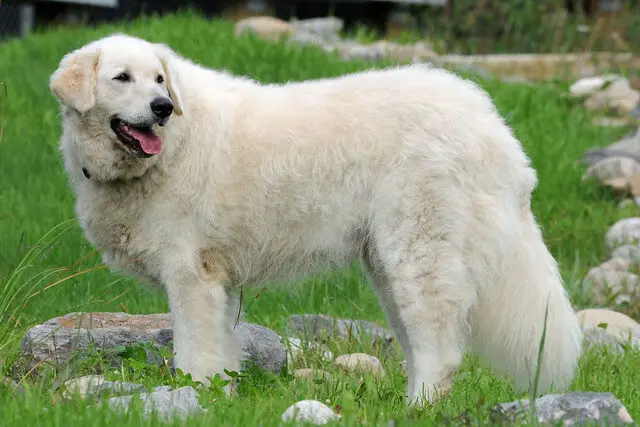
Breed history
This dog breed might as well be the oldest of old Hungarian dog breeds. The other two are, of course, the Komodor and the Puli. Some canine historians believe that the Kuvasz arrived with the old tribes that invaded Hungarian territories nearly 12 centuries ago. Some disagree and say that these tribes simply adopted dogs that were already there when they invaded.
Their name most likely derived from the word “kawasz” a Turkish word that roughly translates to “bodyguard”. This is the most widely accepted theory although there is another that claims that their name comes from the Sumerian expression “ku assa”. That expression referred to dogs that were used as guardians and “ran alongside men and horses”.
We still cannot be entirely sure about their origin but what we do know is that by the 15th century these dogs had an impeccable reputation as guard dogs among Hungarian royalty and noblemen. The most famous among them was King Matias I. He was an old Hungarian king that was crowned in 1464 and at that time he was only 15 years old. From a very young age, King Matias I was considered a wise military strategist and king. His army was one of just a few that managed to fight off the Ottomans and expand Hungarian territory. The young king had a difficult time even at his palace and was betrayed many times by his own family. He couldn’t trust anyone. The only thing he put his trust in was his loyal Kuzasz. It is said that he used to take his dog everywhere he went and felt safe as long as his dog was with him.
King Matias I was so fond of these dogs that he organized large kennels that were home for hundreds and hundreds of Kuvasz dogs. He had many uses for them except the guarding of people and estates. These dogs were also used for hunting and guarding the livestock. He even used them as official gifts when guests and emissaries from other countries came to visit. Because of that, the Kuvaszok became very popular across Europe.
One of the most famous noblemen that came to visit King Matias I was the aforementioned Prince of Wallachia, Vlad Dracula. Vlad became a vassal to King Matias I and had a complicated relationship with him over the years. At one point, Vlad was imprisoned by King Matias. He remained locked for many years. After his release, Prince Vlad married a relative of King Matias and as a wedding gift, he gave Prince Vlad and his bride two Kuvaszok.
After the death of King Matias I, this breed couldn’t keep its high position among the nobility and royal families. They were, however, still used for guarding duties.
This breed was mostly working breed until the 1800s when breeders started getting interested in them and decided that they will standardize the breed and take control of the quality and breeding. 40 years later these dogs became the most popular large breed across the western part of Europe as well as Hungary.
The hardest times for this breed, like many other dog breeds, was during World War II. We already mentioned that this breed nearly went extinct as many of them were killed by Nazi soldiers for trying to defend their family and property.
At the end of the war, there were less than 30 pureblooded dogs left in their native land. The Soviets that occupied Hungary weren’t too keen on dog breeding as they saw it as a hobby of the rich. The Soviet socialist regime used to punish breeders because they viewed them as aristocrats.
Hungarian people staged a large revolution in 1956 and freed themselves of the Soviets. Slowly the life conditions became better and the quality of life returned to Hungary. With that, these dogs started to regain their former glory and their numbers were once again on the rise. Breeding Clubs across the world have been set up and the breeding process was carefully conducted. However, the consequences of the decimation of this breed weren’t left unnoticed and the remaining gene pool was extremely small. Some breeders decided to introduce different breeds to the Kuvasz to avoid inbreeding and to save this breed from extinction.
Their first public dog show participation was in 1883 when the famous Count d'Esterházy, who was a Kuvasz enthusiast and lover, decided to show two of his dogs in a Vienna dog show. A year later the first breed standard was put in place.

Dog breed characteristics
The Kuvasz is a large dog, slightly longer than tall, has dark, almond-shaped eyes, dropped ears, and a long, furry tail. This dog is strong, sturdy, and well-muscled. This ancient breed is recognized and registered in nearly all major cynology associations and has a full breed standard in place. The two major standards we will be focusing on is the Fédération Cynologique Internationale or the FCI and the American Kennel Club or the AKC. The FCI is an association of governing national cynology associations that has 98 members such as Russia, Hungary, Ukraine, Germany, Chile, Japan, Spain, etc. All of these member states have agreed upon a standard that should be official for this breed and the main opinion in this dog breeds standard had their country of origin Hungary.
The American Kennel Club is in charge of all dog-related activities in the United States of America such as dog shows, confirmation, certification as well as sanctioning anybody that is not complying with a good-natured breeding practice. They keep the records of all pureblooded dogs in the United States. The standards of these two major cynology associations are as follows:
FCI standard
As we already mentioned, the FCI standard is based on the original Kuvasz standard that was written in 1884 and later adopted by Hungary’s national cynology association. This standard describes these dogs as great watch and guard dogs. They excel at guarding houses, property, valuables, and people. These dogs have also been used for hunting purposes. The Kuvasz is a part of Group 1 (Sheepdogs and CattleDogs, except Swiss Cattle Dogs), Section 1 (Sheepdogs). They do not have a working trial. These dogs are very strong and quite large. They have a dense, wavy, white coat.
This standard has defined an ideal size of these dogs and it is 71 – 76 cm (28 – 30 in) for the males and 66 – 70 cm (26 – 27,5 in) with the ideal weight of 48 – 62 kg (106 – 137 lb) for the males and 37 – 50 kg (81,5 – 110 lb) for the females.
This breed has been registered by the FCI on the 10th of August 1954.
AKC standard
The American Kennel Club is one of the oldest cynology associations and one of the most influential. It was founded in 1884 and until today recognizes 202 different dog breeds.
One of these recognized and registered breeds is also the Kuvasz and the AKC has a standard for this breed. The standard describes these dogs as great working dogs of larger size. They also say that they are sturdily built, well balanced, neither lanky nor cobby. The Kuvasz should be white with no markings.
They have an ideal standard for these dogs in place and it says that males should be 71 – 76 cm (28 – 30 in) and weigh 45 – 52 kg (100 – 115 lb). The females should have a height of 66 – 71 cm (26 – 28 in) and weigh 32 – 41 kg (70 – 90 lb).
The Kuvasz has been recognized by the AKC in 1931.

Care and grooming
These dogs do not require too much care and grooming. The Kuvasz’s coat is naturally without a scent and is repelling water as well as dirt, so there is no reason you should bathe them too often. Bathing them regularly can cause more problems because their coat will lose it’s natural protective oils and will only make your dog get dirty quicker and more often.
You should get your dog used to grooming, especially brushing as early as possible. They have a thick coat and regular brushing should be a must.
FUN FACT: Kuvaszok lose a lot of their hair during the summer. Still, they can have trouble in extreme heat. Make sure your Kuvasz always has access to freshwater and plenty of shade.
Keep in mind that, except for dirt, this dog sheds a lot of hair, also. These dogs shed heavily, especially during shedding seasons (in the spring and the fall).
FUN FACT: A lot of people clean their dog’s coat by sprinkling talcum powder or cornstarch into the coat and then simply brush the dirt out of the coat.
The rest is basic care – trim your dog’s nails regularly, trim the fur between the toes, brush the dog’s teeth, and occasionally check (and clean) dog's ears.
Energy level
Kuvaszok were bred as working dogs and they love to have a job. These dogs are used to be active all day long. Make sure to give you Kuvasz dog enough daily exercise. Moderate daily exercise is enough for these dogs, but as Kuvasz are massive dogs they are not suited for apartments without access to a large yard surrounded by a solid fence. Long walks during the day and a possibility to play and roam around some more around the yard are an ideal combination for this breed. If not exercised properly (and left alone for too long), Kuvaszok can get destructive or aggressive.
This dog grows fast and may develop joint problems, so never over-exercise a young, growing puppy.
Behavior and socialization
The Kuvasz is an extremely intelligent, but challenging breed. The Kuvasz is slow to mature, strong-willed, and can be aloof and unresponsive to the owner’s commands. This, combined with their size and strength, makes these dogs not suited for an inexperienced owner. The owner/trainer must be positive, persistent, and consistent. This dog responds well to praise and rewards, especially to tasty treats. These dogs were genetically predisposed to be leaders, so the owner must establish himself as a leader from day one. Socialization is an essential part of the training. Exposing the dog to different sounds, sights, animals, and people helps him to become well-adjusted. If not socialized properly, this dog can be overly-suspicious, timid, or aggressive, especially to new people. Towards other animals, they are often dominant or aggressive. They have a strong instinct to drive away any animal that does not belong to their flock (family). They also have strong territorial instincts; they are extremely devoted to their family and are fierce in protecting the family and their property. If they were raised together, the Kuvasz will be highly protective and gentle with the family’s children. However, dog this big should never be left unsupervised with small children.
FUN FACT: These dogs bark on anything that they consider to be a threat. They have deep, booming barks that can drive you (and your neighbors) crazy.

Health problems
The Kuvasz has a lifespan of 10-12 years. They generally live a long and healthy life, but, as all the breeds are, the Kuvasz is also prone to certain health conditions. These health conditions are hip dysplasia, osteochondritis dissecans (OCD – a joint disorder often seen in young, fast-growing dogs of the larger breeds), bloat, von Willebrand's Disease (an inherited blood clotting disorder), progressive retinal atrophy (PRA - an inherited disease of the retina), etc.
Kuvasz breeders
Always buy a puppy from a reputable breeder who will answer all of your questions, and will show you health clearances from puppy’s parents and siblings. An important thing to do if you are interested in this breed is that you have to make sure that a Kuvasz fits your lifestyle. It is a specific breed with a specific character and needs and you have to make sure that you have sufficient time to invest in raising your dog.
FUN FACT: For a dog so large, the Kuvasz needs surprisingly little food.
World Dog Finder team










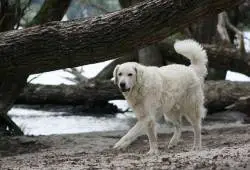











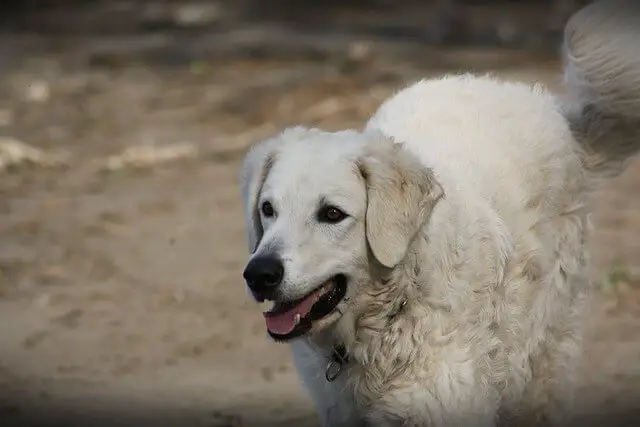


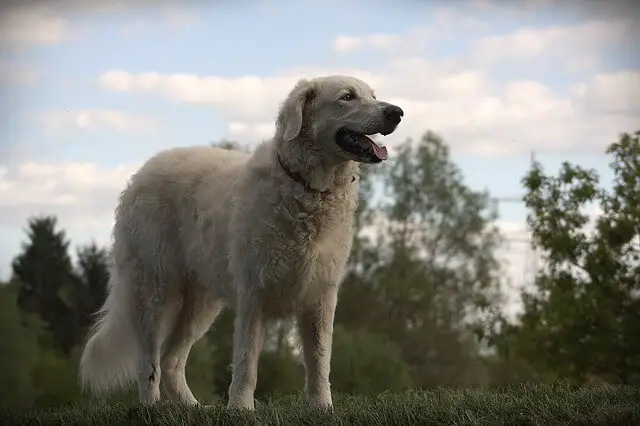




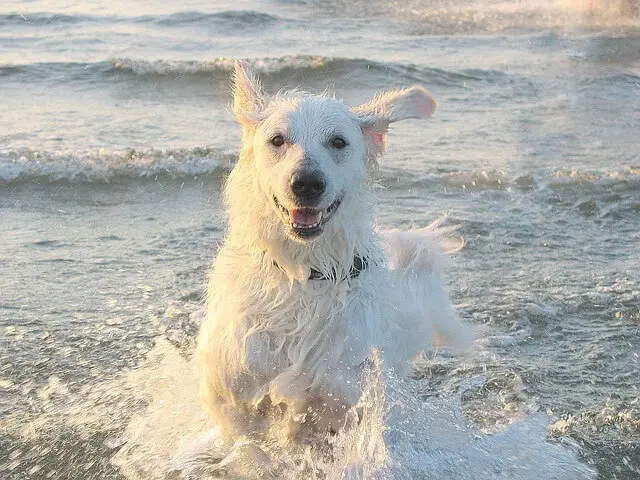






Share